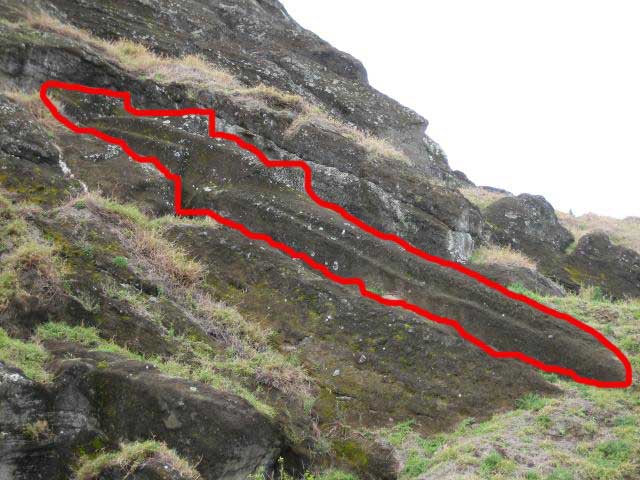| Rongorongo hieroglyphic script |
Translation by Darren |
 |
I’ve fallen down a hill and I cannot get up. Please call the elders and/or the Healer. I have a big date tonight and I do not want to be late. |
 |
Caught some fish today. They were really big. But we had to throw them back because of the new Fishing and Wildlife Secretary. |
 |
I’ve made some urns. Some of them look like cacti. Come and look at them.
I accept MasterCard and VISA. |
 |
Yes, I would like to SuperSize my order. And please don’t skimp on the truffle oil. |
 |
Check out my new dance moves. Here’s one where I spin on my head. Here’s another one where I separate my hand from my body. |
September 29, 2006
I got burned today. A sunburn. Not bad, but it’s pretty much Nicky’s fault. To date in our 18 year relationship (two years dating and 16 wonderful years married, which really seems like 4), she’s been exemplary at reminding me to put sunscreen on. This is a female’s duty. Every wife/girlfriend must do the same. Guys just don’t do sunscreen well. If it weren’t for the females on this planet, every guy would look like a lobster.
So Nicky has, up until today, been faithfully reminding me to apply sunscreen.
I remember why I don’t like sunburns now.
Today we saw the Moai. We toured Rano Raraku, the place on the island that’s considered the Moai factory area, where 394 Moai are still hanging around. What’s a Moai? Take a look:
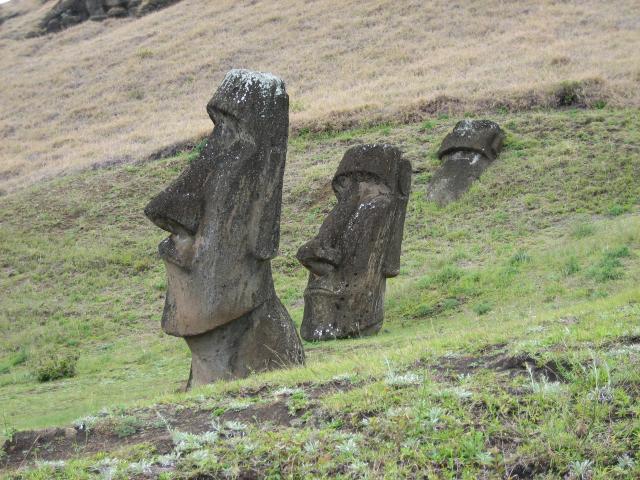
Moai are The Big Freakin’ Heads (BFH). Actually, Moai are heads with truncated torsos, but it’s more fun to call them BFH. The average size of BFH is about 21 feet and weighs about 70 tons; the largest standing BFH is about 33 feet tall and weighs about 82 tons; there’s an unfinished one that’s about 21 meters tall (~63 feet) which is estimated to weigh about 270 tons! That’s a lot of rock.
Can you see the really, really big head (RRBH--21 meters tall) in the picture below?:
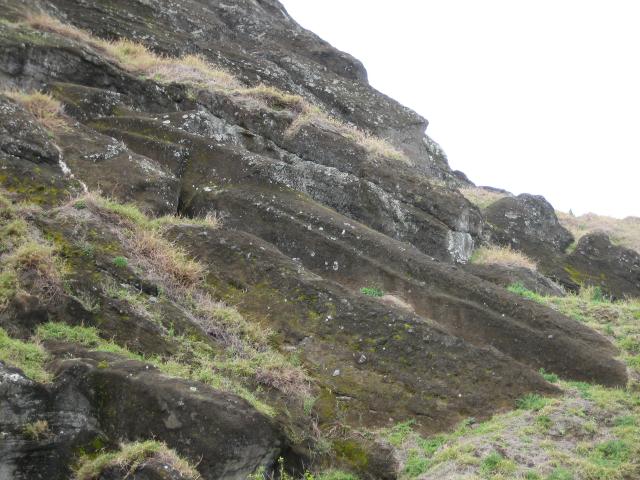
Scroll down to the bottom of this page to see the RRBH.
So what’s the deal with BFH’s? They’re huge statues made from basalt, which is compressed volcanic ash, which is convenient since there are several volcanoes on EI. Who made these, and why did they make these, and why did they stop?
Answer: Nobody knows, nobody knows, nobody knows.
The best guessers to date think that the people that populated EI came from Polynesia around 1000 AD. The current thinking about the Moai is that they were built to honor and represent their ancestors as well as their current chiefs.
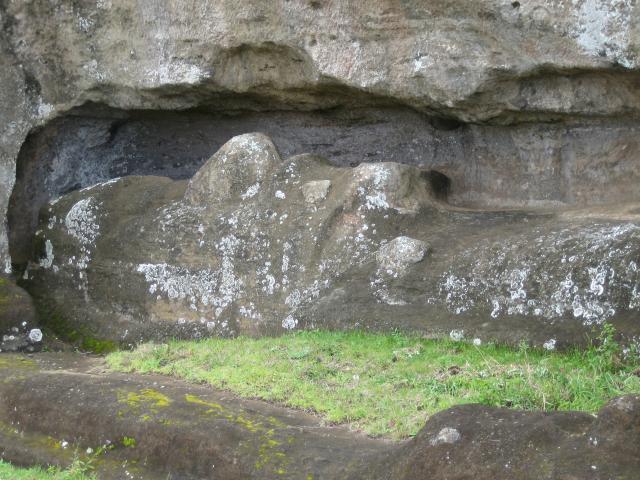
There is some question as to how these huge statues were moved from the “factory” to their eventual resting place—one camp suggests the use of trees used as rollers, which would account for the virtual tree-less island now; the other camp suggests that by using just 17 people and rope you can “walk” the statue to where you want it. A smaller camp says that they used all the trees on the island to build rafts on which to float these BFH. Personally I think the entire island is made up from people that did the, “Candid Camera” TV show.
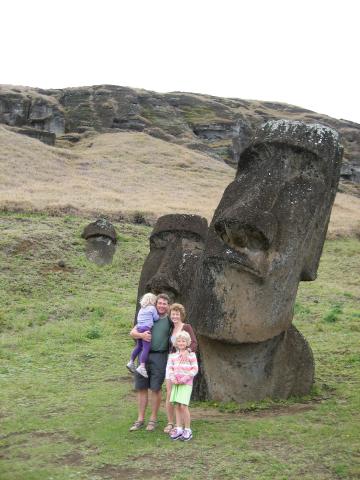
The history of the Rap Nui people is also hotly debated. One of the prevailing theories is that the people were divided into the rich class (i.e. “Long Ears” or people with elongated earlobes), and the working class with normal ears that did the carving of the Moai. So this really isn’t very different than today’s culture—those that can afford plastic surgery, and those that cannot.
Regardless of what you believe, the movers of the BFH were sorely underpaid no matter how you look at it. I’m sure they didn’t have workers compensation back then, and medical/dental coverage was a pipedream. Without the use of hydraulic heavy-lifting equipment, there’s no doubt that these people were underpaid no matter how many fish they were fed.
There’s a decent movie about the Rapa Nui culture produced by Kevin Costner and starring Jason Scott Lee called, “Rapa Nui” (clever name, eh?). http://imdb.com/title/tt0110944/
Dominique got a little too close to one of the BFH:
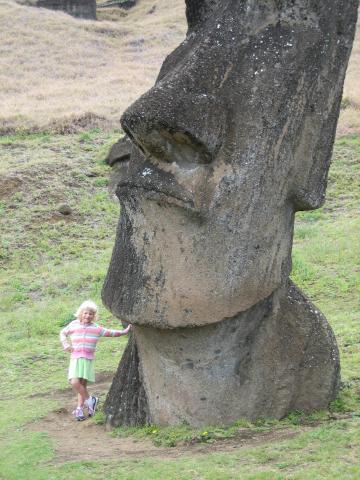
And then she leaned a little too hard on it:
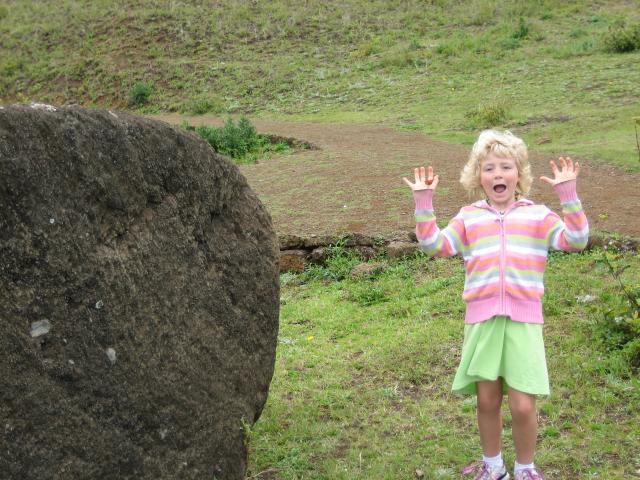
Dominique also found one that had an itchy nose and she volunteered to scratch it:
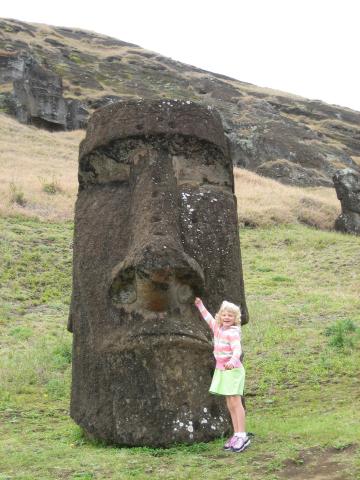
These things are so large, and so freaky and so populous and so available to visitors that I’m gonna put a bunch of these pictures here. Take a gander of the largest, most bizarre statues on the most remote island on the planet. Enjoy:


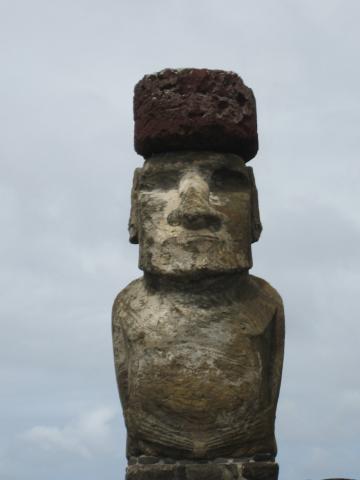

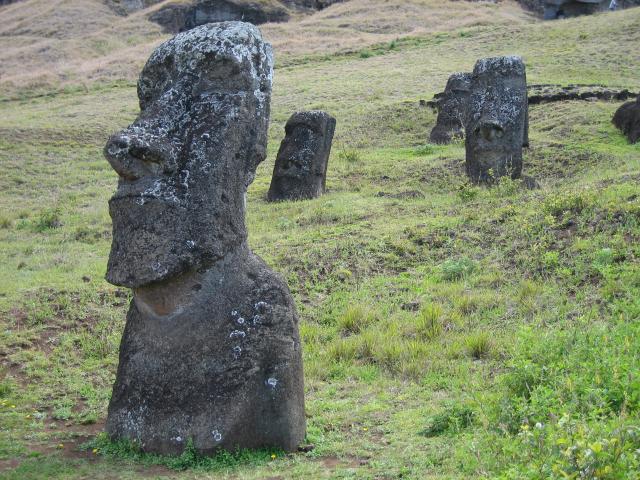
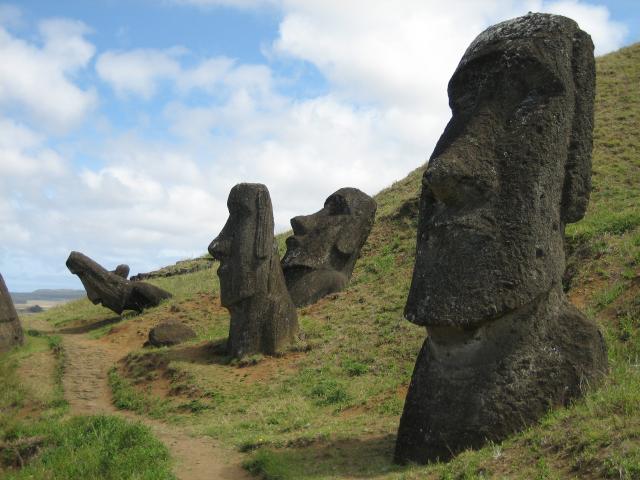
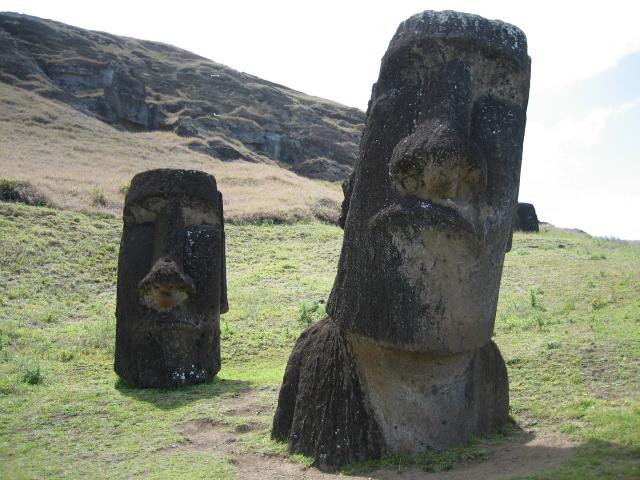
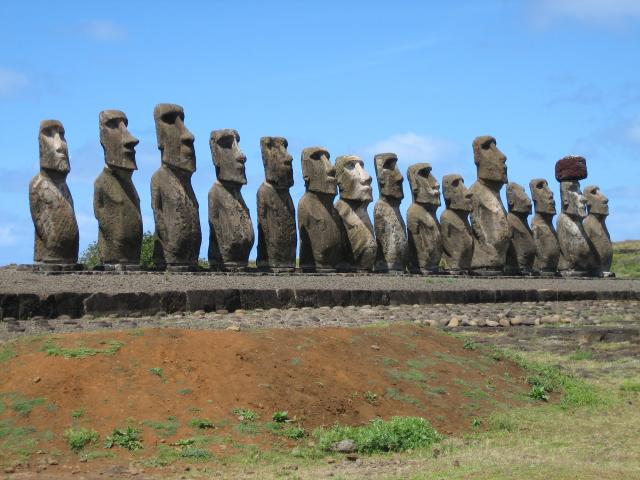
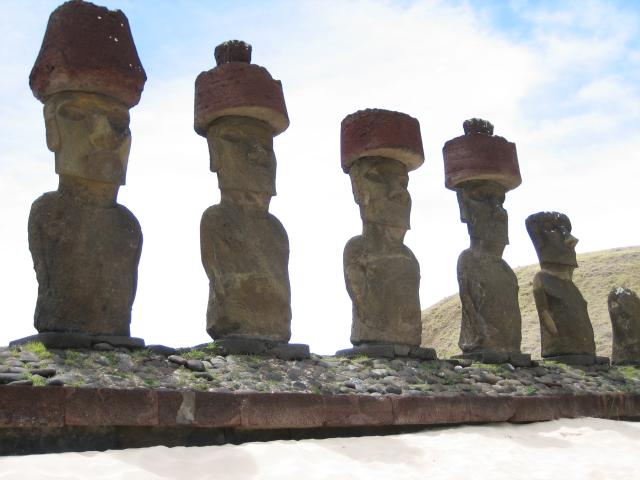
Video: BFH Factory
Note: if you can not see the video, download QuickTime and view the movie with it.

Video: Walking amoung Moai
And here’s the most terrifying Moai head of them all:
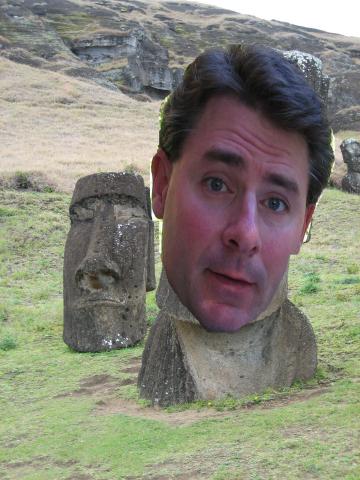
Frightening, eh?
Today was a triumph on several levels. We managed to get cash and we managed to feed ourselves. Nicky can understand and speak Spanish better than I, but then again so can Dominique and Annette. Did I mention that they speak Spanish here? EI is part of Chile. Huh.
First our banking success—it took me about 4 days to understand the money here. It’s the Chilean peso. The money was confusing to me for several reasons:
- They don’t use a comma; they use a decimal point when they write numbers. I thought it was some something distantly related to rongorongo.
- They use the “$” symbol to signify pesos. They also use the “$” to signify the US dollar. How confusing is that?!
- On many things they list both the price in pesos and the price in US dollars. Combine that with the same “$” figure and it gets very frustrating.
- Everything costs more than $10.000 pesos, which is really written as $10,000, which is about 2.5 cents. For instance, a can of coke is about $1.230.000.000, or sometimes they write is as scientific notation: $1.230 x 109 (just kidding). I now know why they give you a complimentary wheel barrow when you get cash from the bank—you have to use something like that to carry all the notes and coins.
- American ATM cards do not work here. There’s only one bank and one ATM on the island. For Americans to get cash we have to enter the bank, go to one specific Customer Service representative, have him call someone for verification, and then get our dough. AND you have to show them your passport, get fingerprinted, give a blood sample, pee in a cup, and turn your head and cough (I just made this last part up). LASTLY, the maximum we can get each day is $200.000 pesos, which is really $200,000 pesos, which is enough to get your hair cut if you’re bald.
It’s crazy man.
We ate at a restaurant the first night we were here. We ordered 3 dishes: chicken with rice, fish with rice, and steak with rice. We also had two bottled waters and two beers. The total for the diner was $25.000 pesos, which is really $25,000 pesos, which is about $50.00 US. YIKES! That’s pretty expensive for only 3 dinners! I know, you people in the states might not think that $50 for 4 people for dinner is reasonable price, but this is not the states, and those weren’t close to the quality of dinners you could get in the states.
But we conquered the language barrier and we fed ourselves. From then on we ordered empanadas from a local vendor at a cost of $2 per empanada. Much better deal and the food was better too.
We met a family from Switzerland that was also touring EI and we hung out with them for the day. Talk about a different lifestyle—they have been touring the world for the past 4 years with an organization they created called Top to Top (www.toptotop.org). Their goal is to reach children in schools all across the world and share with them environmental issues. They also will climb the highest peaks on each continent, although I’m still not sure what the climbing has to do with the environmental stuff. But they’re doing all of this with a 17 month old infant, and doing it all without any mechanized form of transportation. They sail from place to place, and either walk or bike on land.
These guys were really interesting to hang out with. A cynic would say that they get their sponsors to transport them to each continent so they can climb mountains for free (they’re both mountain climbers of many, many years, which seems to be their passion). This is a pretty good gig for them, and I think there’s a little bit of truth to this, but they are also passionate about the environment and live an extremely frugal lifestyle. And they’re really consistent in their commitment to use only human power to go from point A to B (the wife wouldn’t use an escalator to purchase socks from the second floor of a store—she asked them to bring a ladder so she could climb up!).
So this magical island of Rapa Nui, or Easter Island, or EI, or Te Pito O Te Henua was a great 5 days. The entire island is served by one bank, by one ATM, by one gas station and one airport. They have two police cars; and the entire town shuts down from 1pm – 5pm for a siesta.
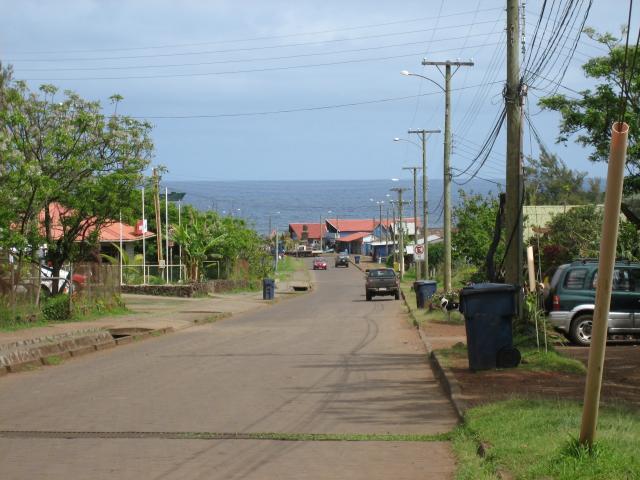
Seriously. We didn’t properly plan for the sleepy-time and it was a hassle the first two days. We didn’t get enough water or snacks, and we had to hunt for a very small convenience store that was open at 3pm. The bank closes everyday at noon! But this small island was a huge highlight for us on our trip. With the BFH’s, rongorongo, and only one ATM on the place, how could you not fall in love with it?
ANSWER TO REALLY REALLY BIG HEAD PICTURE:
Here’s the RRBH that I’ve outlined in red. Did you spot it? Good! 10 points to you. Uh… you really can’t do anything with these points; it’s more a virtual pat-on-the-back.
